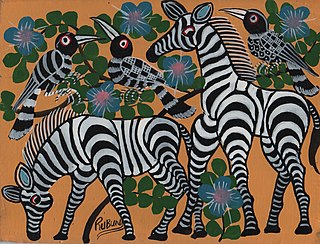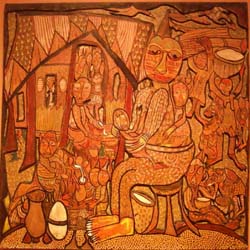
Wood carving is a form of woodworking by means of a cutting tool (knife) in one hand or a chisel by two hands or with one hand on a chisel and one hand on a mallet, resulting in a wooden figure or figurine, or in the sculptural ornamentation of a wooden object. The phrase may also refer to the finished product, from individual sculptures to hand-worked mouldings composing part of a tracery.

African art describes the modern and historical paintings, sculptures, installations, and other visual culture from native or indigenous Africans and the African continent. The definition may also include the art of the African diasporas, such as: African-American, Caribbean or art in South American societies inspired by African traditions. Despite this diversity, there are unifying artistic themes present when considering the totality of the visual culture from the continent of Africa.

The Makonde are an ethnic group in southeast Tanzania, northern Mozambique, and Kenya. The Makonde developed their culture on the Mueda Plateau in Mozambique. At present they live throughout Tanzania and Mozambique, and have a small presence in Kenya. The Makonde population in Tanzania was estimated in 2001 to be 1,140,000, and the 1997 census in Mozambique put the Makonde population in that country at 233,358, for an estimated total of 1,373,358. The ethnic group is roughly divided by the Ruvuma River; members of the group in Tanzania are referred to as the Makonde, and those in Mozambique as the Maconde. The two groups have developed separate languages over time but share a common origin and culture.

A chess set consists of a chessboard and white and black chess pieces for playing chess. There are sixteen pieces of each color: one king, one queen, two rooks, two bishops, two knights, and eight pawns. Extra pieces may be provided for use in promotion, most commonly one extra queen per color. Chess boxes, chess clocks, and chess tables are common pieces of chess equipment used alongside chess sets. Chess sets are made in a wide variety of styles, sometimes for ornamental rather than practical purposes. For tournament play, the Staunton chess set is preferred and, in some cases, required.

Ivory carving is the carving of ivory, that is to say animal tooth or tusk, generally by using sharp cutting tools, either mechanically or manually. Objects carved in ivory are often called "ivories".

George Lilanga was a Tanzanian painter and sculptor, active from the late 1970s and until the early 21st century. He belonged to the Makonde people and lived most of his life in Dar es Salaam, the largest city in Tanzania.

The Staunton chess set is the standard style of chess pieces, recommended for use in competition by FIDE, the international chess governing body.

Haida argillite carvings are a sculptural tradition among the Haida indigenous nation of the Northwest Coast of North America. It first became a widespread art form in the early 19th century, and continues today.
The Bwa is an African society that is native to Burkina Faso. This society has an approximate population of over 300,000 persons. The Bwa people live in a number of individualized communities. They have no central government, and rely on their community standards. They are most known for their scarification and elaborate plank masks.

Toi whakairo or just whakairo (carving) is a Māori traditional art of carving in wood, stone or bone.

Shetani are spirits of East African mythology and popular belief. Mostly malevolent, and found in many different forms and different types with different powers, shetani are a popular subject of carved artwork, especially by the Makonde people of Tanzania, Mozambique, and Kenya. Physically, shetani of various types appear as distorted human and animal figures.

Tingatinga is a painting style that originated in East Africa. Tingatinga is one of the most widely represented forms of tourist-oriented paintings in Tanzania, Kenya and neighbouring countries. The genre is named after its founder, Tanzanian painter Edward Tingatinga. Tinga Tinga also insipired kids animation tales, namely Tinga Tinga Tales.

Healing of Abiku Children is a piece created by the Nigerian artist Twins Seven-Seven in 1973, located in the Indianapolis Museum of Art, which is in Indianapolis, Indiana, United States of America. It consists of a large wooden plaque intricately carved and dyed with pigment to depict an important Yoruba ceremony. In it, a mother consults with a priest to keep her abiku twins in this world, rather than dying and being reborn to her over and over.
The name Makonde art refers to East African sculptures or, less frequently, to modern paintings created by craftspeople or artists belonging to the Makonde people of northern Mozambique and southern Tanzania, separated by the Ruvuma river. Art historians, dealers and collectors have created this genre of African art, that can be subdivided into African traditional artifacts or modern artistic works. This genre can be traced back to the 1930s, when the first documented exhibition of Makonde art was held at the Centro Cultural dos Novos in Mozambique.
African ivories are objects and materials that are created from ivory or include ivory material that comes from the continent of Africa. The ivory from Africa would become widely sought after by the 14th century due in part to the poorer quality of Asian ivory. While Asian ivory is brittle, more difficult to polish, and tends to yellow with exposure to air, African ivory often comes in larger pieces, a more sought after cream color, and is easier to carve. Ivory from Africa came from one of two types of elephant in Africa; the more desirable bush elephant with larger and heavier tusks or the forest elephant with smaller and straighter tusks.

The Dubrovnik chess set is a style of chess pieces influenced by the Staunton chess set and used to play the game of chess. These chessmen are considered to have significant historical importance and are regarded as a timeless design classic. Over the decades several variants of the Dubrovnik chessmen were designed.
Ulysses Davis was an African-American barber and self-taught sculptor. Davis is best known for his carvings of historical figures such as a set of mahogany busts of all the presidents and similar portrait heads of the Rev. Dr. Martin Luther King Jr., the Kennedys and other leaders from the civil rights era.
The Mueda Plateau, also known as the Maconde Plateau, is a plateau in Cabo Delgado Province of northeastern Mozambique.

Reinata Sadimba is a Mozambican ceramicist who produces work that originates in traditional Makonde pottery, while incorporating her own techniques and conceptions of femininity and motherhood. She is considered among the most important contemporary sculptors in Mozambique.

Scarification in Africa is a major aspect of African cultures and cultural practice among African ethnic groups; the practice of scarification in Africa includes the process of making "superficial incisions on the skin using stones, glass, knives, or other tools to create meaningful pictures, words, or designs" and expresses "clan identity, status within a community, passage into adulthood, or spiritual significance."















